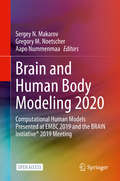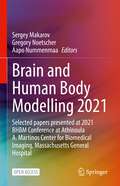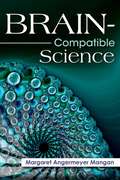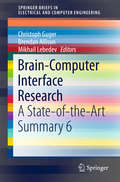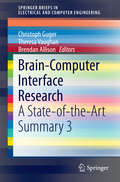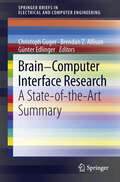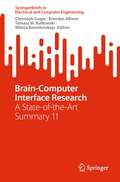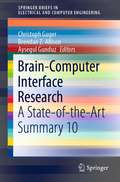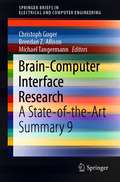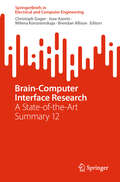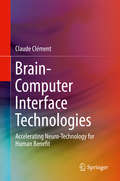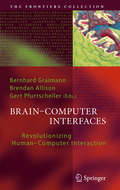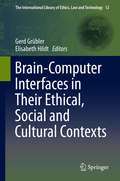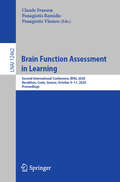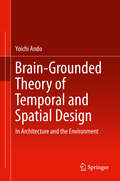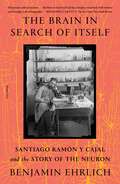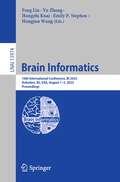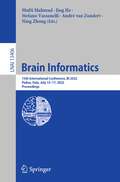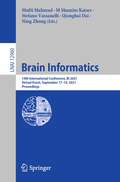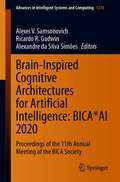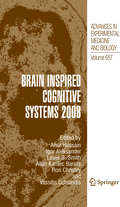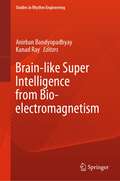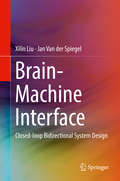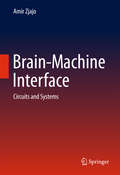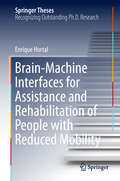- Table View
- List View
Brain and Human Body Modeling 2020: Computational Human Models Presented at EMBC 2019 and the BRAIN Initiative® 2019 Meeting
by Gregory M. Noetscher Sergey N. Makarov Aapo NummenmaaThis open access book describes modern applications of computational human modeling in an effort to advance neurology, cancer treatment, and radio-frequency studies including regulatory, safety, and wireless communication fields. Readers working on any application that may expose human subjects to electromagnetic radiation will benefit from this book’s coverage of the latest models and techniques available to assess a given technology’s safety and efficacy in a timely and efficient manner.Describes computational human body phantom construction and application;Explains new practices in computational human body modeling for electromagnetic safety and exposure evaluations;Includes a survey of modern applications for which computational human phantoms are critical.
Brain and Human Body Modelling 2021: Selected papers presented at 2021 BHBM Conference at Athinoula A. Martinos Center for Biomedical Imaging, Massachusetts General Hospital
by Sergey Makarov Gregory Noetscher Aapo NummenmaaThis open access book describes modern applications of computational human modelling to advance neurology, cancer treatment, and radio-frequency studies including regulatory, safety, and wireless communication fields. Readers working on any application that may expose human subjects to electromagnetic radiation will benefit from this book’s coverage of the latest models and techniques available to assess a given technology’s safety and efficacy in a timely and efficient manner.This is an Open Access book.
Brain-Compatible Science
by Margaret Angermeyer ManganGain fresh insights for teaching, learning, and assessing knowledge of critical science concepts through the exploration of research-based practices for science education.
Brain-Computer Interface Research: A State-of-the-Art Summary 6 (SpringerBriefs in Electrical and Computer Engineering #6)
by Brendan Allison Christoph Guger Mikhail LebedevBrain-computer interfaces (BCIs) are rapidly developing into a mainstream, worldwide research endeavor. With so many new groups and projects, it can be difficult to identify the best ones. This book summarizes ten leading projects from around the world. About 60 submissions were received in 2011 for the highly competitive BCI Research Award, and an international jury selected the top ten. This Brief gives a concise but carefully illustrated and fully up-to-date description of each of these projects, together with an introduction and concluding chapter by the editors.
Brain-Computer Interface Research: A State-of-the-Art Summary 3 (SpringerBriefs in Electrical and Computer Engineering #6)
by Brendan Allison Christoph Guger Theresa VaughanThis book provides a cutting-edge overview of the latest developments in Brain-Computer-Interfaces (BCIs), reported by leading research groups. As the reader will discover, BCI research is moving ahead rapidly, with many new ideas, research initiatives, and improved technologies, e. g. BCIs that enable people to communicate just by thinking - without any movement at all. Several different groups are helping severely disabled users communicate using BCIs, and BCI technology is also being extended to facilitate recovery from stroke, epilepsy, and other conditions. Each year, hundreds of the top BCI scientists, engineers, doctors, and other visionaries compete for the most prestigious honor in the BCI research community: the annual BCI Award. The 2013 BCI Award competition was by far the most competitive, with over 160 research groups vying for a nomination. The chapters of this book summarize the ten projects that were nominated, in particular the winning project, and analyses how these reflect general trends in BCI development. Each project summary includes an introduction, description of methods, results, and also includes newer work completed after the project was entered for the competition. The texts are presented in accessible style with numerous supporting pictures, graphs, and figures.
Brain-Computer Interface Research: A State-of-the-Art Summary (SpringerBriefs in Electrical and Computer Engineering #6)
by Brendan Z. Allison Christoph Guger Günter EdlingerBrain-computer interfaces (BCIs) are rapidly developing into a mainstream, worldwide research endeavor. With so many new groups and projects, it can be difficult to identify the best ones. This book summarizes ten leading projects from around the world. About 60 submissions were received in 2011 for the highly competitive BCI Research Award, and an international jury selected the top ten. This Brief gives a concise but carefully illustrated and fully up-to-date description of each of these projects, together with an introduction and concluding chapter by the editors.
Brain-Computer Interface Research: A State-of-the-Art Summary 11 (SpringerBriefs in Electrical and Computer Engineering)
by Christoph Guger Brendan Allison Tomasz M. Rutkowski Milena KorostenskajaThis book showcases recent trends in brain-computer interface development. It highlights fascinating results in areas such as language decoding, spinal cord stimulation to enable gait and to restore hand functions. The contributions are based on the 12 nominated brain-computer interface projects of the BCI Award 2022. Every year an international jury selects the most innovate BCI projects and nominates 12 projects before selecting the 1st, 2nd and 3rd place winners. In the book, each project is described in detail by the team of scientists behind it, and the editors provide a concluding discussion of the highlights and overall progress in the field.
Brain-Computer Interface Research: A State-of-the-Art Summary 10 (SpringerBriefs in Electrical and Computer Engineering)
by Christoph Guger Brendan Z. Allison Aysegul GunduzThe Annual BCI Research Awards are international prizes that recognize the top new projects in brain–computer interface (BCI) research. This book contains concise descriptions of projects nominated for the 2020 BCI Research Award and interviews with nominees. Each article is authored by the researchers who developed the project, and articles have been updated with new progress achieved since their nomination. These chapters are complemented by an introduction by the editors together with a concluding chapter that reviews the annual Awards Ceremony, announces the winners, and ends with a brief discussion.One of the prominent trends in recent years has been the development of BCIs for restoring limb use and for aiding optical and auditory sensory perception. Many chapters in this book present emerging and novel research directions likely to become more prevalent in the near future. This year's book includes chapters based on interviews with BCI experts who were nominated for an award, including this year's first, second, and third place winners. These interview chapters are generally less technical than project descriptions, and provide individual perspectives from people actively working on new methods and systems.
Brain-Computer Interface Research: A State-of-the-Art Summary 9 (SpringerBriefs in Electrical and Computer Engineering)
by Christoph Guger Brendan Z. Allison Michael TangermannThe Annual BCI Research Awards are international prizes that recognize the top new projects in brain–computer interface (BCI) research. This book contains concise descriptions of projects nominated for the 2019 BCI Research Award and interviews with nominees. Each article is authored by the researchers who developed the project, and articles have been updated with new progress achieved since their nomination. These chapters are complemented by an introduction by the editors together with a concluding chapter that reviews the annual Awards Ceremony, announces the winners, and ends with a brief discussion.One of the prominent trends in recent years has been the development of BCIs for new patient groups. Many chapters in this book present emerging and novel research directions likely to become more prevalent in the near future. This year's book includes chapters based on interviews with BCI experts who were nominated for an award, including this year's first, second, and third place winners. These interview chapters are generally less technical than project descriptions, and provide individual perspectives from people actively working on new methods and systems.
Brain-Computer Interface Research: A State-of-the-Art Summary 12 (SpringerBriefs in Electrical and Computer Engineering)
by Christoph Guger Jose Azorin Milena Korostenskaja Brendan AllisonThis book showcases recent trends in brain-computer interface development. It highlights fascinating results in areas such as speech neuroprotheses, bionic hands, memory enhancement, and the development of optical BCIs . The contributions describe the three winning projects and other nominated brain-computer interface projects selected by the expert international jury of the BCI Award 2023. In the book, each project is described in detail by the team of scientists behind it, and the editors provide a concluding discussion of the highlights and overall progress in the field.
Brain-Computer Interface Technologies: Accelerating Neuro-Technology for Human Benefit
by Claude ClémentThis book is about the field of brain-computer interfaces (BCI) and the unique and special environment of active implants that electrically interface with the brain, spinal cord, peripheral nerves, and organs. At the heart of the book is the matter of repairing and rehabilitating patients suffering from severe neurologic impairments, from paralysis to movement disorders and epilepsy, that often requires an invasive solution based on an implanted device. Past achievements, current work, and future perspectives of BCI and other interactions between medical devices and the human nervous system are described in detail from a pragmatic point of view.Reviews the Active Implantable Medical Devices (AIMDs) industry and how it is moving from cardiac to neuro applicationsClear, easy to read, presentation of the field of neuro-technologies for human benefitProvides easy to understand explanations about the technical limitations, the physics of implants in the human body, and realistic long terms perspectives
Brain-Computer Interfaces: Revolutionizing Human-Computer Interaction (The Frontiers Collection #6)
by Gert Pfurtscheller Bernhard Graimann Brendan Z. AllisonA brain-computer interface (BCI) establishes a direct output channel between the human brain and external devices. BCIs infer user intent via direct measures of brain activity and thus enable communication and control without movement. This book, authored by experts in the field, provides an accessible introduction to the neurophysiological and signal-processing background required for BCI, presents state-of-the-art non-invasive and invasive approaches, gives an overview of current hardware and software solutions, and reviews the most interesting as well as new, emerging BCI applications. The book is intended not only for students and young researchers, but also for newcomers and other readers from diverse backgrounds keen to learn about this vital scientific endeavour.
Brain-Computer-Interfaces in their ethical, social and cultural contexts (The International Library of Ethics, Law and Technology #12)
by Elisabeth Hildt Gerd GrüblerThis volume summarizes the ethical, social and cultural contexts of interfacing brains and computers. It is intended for the interdisciplinary community of BCI stakeholders. Insofar, engineers, neuroscientists, psychologists, physicians, care-givers and also users and their relatives are concerned. For about the last twenty years brain-computer-interfaces (BCIs) have been investigated with increasing intensity and have in principle shown their potential to be useful tools in diagnostics, rehabilitation and assistive technology. The central promise of BCI technology is enabling severely impaired people in mobility, grasping, communication, and entertainment. Successful applications are for instance communication devices enabling locked-in patients in staying in contact with their environment, or prostheses enabling paralysed people in reaching and grasping. In addition to this, it serves as an introduction to the whole field of BCI for any interested reader.
Brain Function Assessment in Learning: Second International Conference, BFAL 2020, Heraklion, Crete, Greece, October 9–11, 2020, Proceedings (Lecture Notes in Computer Science #12462)
by Claude Frasson Panagiotis Bamidis Panagiotis VlamosThis book constitutes the thoroughly refereed proceedings of the Second International Conference on Brain Function Assessment in Learning, BFAL 2020, held in Heraklion, Crete, Greece, in October 2020*.The 11 revised full papers and 10 short papers presented were carefully selected from 35 submissions. The BFAL conference aims to regroup research in multidisciplinary domains such as neuroscience, computer science, medicine, education, human-computer interactions, and social interaction on the theme of Brain Function Assessment in Learning.*The conference was held virtually due to the COVID-19 pandemic.
Brain-Grounded Theory of Temporal and Spatial Design: In Architecture and the Environment
by Yoichi AndoIn this book, brain-grounded theory of temporal and spatial design in architecture and the environment is discussed. The author believes that it is a key to solving such global problems as environmental disorders and severe climate change as well as conflicts that are caused by the ill-conceived notion of "time is money". There are three phases or aspects of a person's life: the physical life, the spiritual or mental life, and the third stage of life, when a person moves from middle age into old age and can choose what he or she wishes to do instead of simply what must be done. This book describes the temporal design of the environment based on the theory of subjective preference, which could make it possible for an individual to realize a healthy life in all three phases. In his previously published work, the present author wrote that the theory of subjective preference has been established for the sound and visual fields based on neural evidence, and that subjective preference is an overall response of cooperating temporal and spatial factors, associated with the brain's left and right hemispheres, respectively. In this book, based on that theory, some examples are shown for the temporal design of architecture and the environment, which may play important roles in the development of personality, thus inducing creativity. Also discussed is how all individuals may find their own personality and develop it according to the preferred direction of their individual lives.
The Brain in Search of Itself: Santiago Ramón y Cajal and the Story of the Neuron
by Benjamin EhrlichThe first major biography of the Nobel Prize–winning scientist who discovered neurons and transformed our understanding of the human mind—illustrated with his extraordinary anatomical drawingsUnless you’re a neuroscientist, Santiago Ramón y Cajal is likely the most important figure in the history of biology you’ve never heard of. Along with Charles Darwin and Louis Pasteur, he ranks among the most brilliant and original biologists of the nineteenth century, and his discoveries have done for our understanding of the human brain what the work of Galileo and Sir Isaac Newton did for our conception of the physical universe. He was awarded the Nobel Prize in 1906 for his lifelong investigation of the structure of neurons: “The mysterious butterflies of the soul,” Cajal called them, “whose beating of wings may one day reveal to us the secrets of the mind.” And he produced a dazzling oeuvre of anatomical drawings, whose alien beauty grace the pages of medical textbooks and the walls of museums to this day.Benjamin Ehrlich’s The Brain in Search of Itself is the first major biography in English of this singular figure, whose scientific odyssey mirrored the rocky journey of his beloved homeland of Spain into the twentieth century. Born into relative poverty in a mountaintop hamlet, Cajal was an enterprising and unruly child whose ambitions were both nurtured and thwarted by his father, a country doctor with a flinty disposition. A portrait of a nation as well a biography, The Brain in Search of Itself follows Cajal from the hinterlands to Barcelona and Madrid, where he became an illustrious figure—resisting and ultimately transforming the rigid hierarchies and underdeveloped science that surrounded him. To momentous effect, Cajal devised a theory that was as controversial in his own time as it is universal in ours: that the nervous system is comprised of individual cells with distinctive roles, just like any other organ in the body. In one of the greatest scientific rivalries in history, he argued his case against Camillo Golgi and prevailed.In our age of neuro-imaging and investigations into the neural basis of the mind, Cajal is the artistic and scientific forefather we must get to know. The Brain in Search of Itself is at once the story of how the brain as we know it came into being and a finely wrought portrait of an individual as fantastical and complex as the subject to which he devoted his life.
Brain Informatics: 16th International Conference, BI 2023, Hoboken, NJ, USA, August 1–3, 2023, Proceedings (Lecture Notes in Computer Science #13974)
by Feng Liu Yu Zhang Hongzhi Kuai Emily P. Stephen Hongjun WangThis book constitutes the proceedings of the 16th International Conference on Brain Informatics, BI 2023, which was held in Hoboken, NJ, USA, during August 1–3, 2023.The 40 full papers presented in this book were carefully reviewed and selected from 101 submissions. The papers are divided into the following topical sections: cognitive and computational foundations of brain science; investigations of human Information processing systems; brain big data analytics, curation and management; informatics paradigms for brain and mental health research; brain-machine intelligence and brain-inspired computing; and the 5th international workshop on cognitive neuroscience of thinking and reasoning.
Brain Informatics: 15th International Conference, BI 2022, Padua, Italy, July 15–17, 2022, Proceedings (Lecture Notes in Computer Science #13406)
by Mufti Mahmud Jing He Stefano Vassanelli André Van Zundert Ning ZhongThis book constitutes the refereed proceedings of the 15th International Conference on Brain Informatics, BI 2022, held as hybrid event in Padua, Italy (in person) and Queensland, Australia (online) in July 2022. The 29 papers were selected from 65 submissions and the main theme of BI 2022 is Brain Science meets Artificial Intelligence with respect to the five tracks: Cognitive and computational foundations of brain science; human information processing systems; brain big data analytics, curation and management; informatics paradigms for brain and mental health research; and brain-machine intelligence and brain inspired computing.
Brain Informatics: 14th International Conference, BI 2021, Virtual Event, September 17–19, 2021, Proceedings (Lecture Notes in Computer Science #12960)
by Mufti Mahmud M Shamim Kaiser Stefano Vassanelli Qionghai Dai Ning ZhongThis book constitutes the refereed proceedings of the 14th International Conference on Brain Informatics, BI 2021, held in September 2021. The conference was held virtually due to the COVID-19 pandemic. The 49 full and 2 short papers together with 18 abstract papers were carefully reviewed and selected from 90 submissions. The papers are organized in the following topical sections: cognitive and computational foundations of brain science; investigations of human information processing systems; brain big data analytics, curation and management; informatics paradigms for brain and mental health research; and brain-machine intelligence and brain-inspired computing.
Brain-Inspired Cognitive Architectures for Artificial Intelligence: Proceedings of the 11th Annual Meeting of the BICA Society (Advances in Intelligent Systems and Computing #1310)
by Alexei V. Samsonovich Ricardo R. Gudwin Alexandre da Silva SimõesThe book focuses on original approaches intended to support the development of biologically inspired cognitive architectures. It bridges together different disciplines, from classical artificial intelligence to linguistics, from neuro- and social sciences to design and creativity, among others. The chapters, based on contributions presented at the Eleventh Annual Meeting of the BICA Society, held on November 10-14, 2020, in Natal, Brazil, discuss emerging methods, theories and ideas towards the realization of general-purpose humanlike artificial intelligence or fostering a better understanding of the ways the human mind works. All in all, the book provides engineers, mathematicians, psychologists, computer scientists and other experts with a timely snapshot of recent research and a source of inspiration for future developments in the broadly intended areas of artificial intelligence and biological inspiration.
Brain Inspired Cognitive Systems 2008 (Advances in Experimental Medicine and Biology #657)
by Leslie S. Smith Ron Chrisley Igor Aleksander Amir Hussain Allan Kardec Barros Vassilis CutsuridisBrain Inspired Cognitive Systems 2008 (June 24-27, 2008; São Luís, Brazil) brought together leading scientists and engineers who use analytic, syntactic and computational methods both to understand the prodigious processing properties of biological systems and, specifically, of the brain, and to exploit such knowledge to advance computational methods towards ever higher levels of cognitive competence. This book includes the papers presented at four major symposia: Part I - Cognitive Neuroscience Part II - Biologically Inspired Systems Part III - Neural Computation Part IV - Models of Consciousness.
Brain-like Super Intelligence from Bio-electromagnetism (Studies in Rhythm Engineering)
by Anirban Bandyopadhyay Kanad RayThis book discusses various aspects of bioinspired technologies but with an additional emphasis on the medical science, starting from the popular article on neurobiology to pure biophysics that ends with the superintelligence of biological systems that could be reverse engineered. It covers eight different aspects of natural intelligence, starting from the fundamental electromagnetic properties of a protein to the vibrations and the resonance of the entire biomaterial system. It also covers a wide spectrum of hierarchical communication among different biological systems for intelligence and then medical science is applied.
Brain-Machine Interface: Closed-loop Bidirectional System Design
by Xilin Liu Jan Van der SpiegelThis book provides an introduction to the emerging area of "Brain-Machine Interfaces," with emphasis on the operation and practical design aspects. The book will help both electrical & bioengineers as well as neuroscience investigators to learn about the next generation brain-machine interfaces. The comprehensive review and design analysis will be very helpful for researchers who are new to this area or interested in the study of the brain. The in-depth discussion of practical design issues especially in animal experiments will also be valuable for experienced researchers.
Brain-Machine Interface: Circuits and Systems
by Amir ZjajoThis book provides a complete overview of significant design challenges in respect to circuit miniaturization and power reduction of the neural recording system, along with circuit topologies, architecture trends, and (post-silicon) circuit optimization algorithms. The introduced novel circuits for signal conditioning, quantization, and classification, as well as system configurations focus on optimized power-per-area performance, from the spatial resolution (i. e. number of channels), feasible wireless data bandwidth and information quality to the delivered power of implantable system.
Brain-Machine Interfaces for Assistance and Rehabilitation of People with Reduced Mobility (Springer Theses)
by Enrique HortalThis book reports on the development of different control tools for Brain-machine interface-based assistance and rehabilitation. Brain activity is analyzed with the purpose of classify mental tasks and detecting movement intentions in patients with impaired motility. Event-Related Desynchronization (ERD) and Event-Related Synchronization (ERS) are detected. Throughout this book, different control systems are presented and validated. This thesis, examined at the Miguel Hernández University of Elche, Spain, in 2016, received the award for best thesis in bioengineering from the Bioengineering group of the Spanish Committee of Automatic Control (CEA) in 2017.
